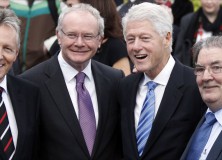The U.S. Role in the Northern Ireland Peace Process — Jessie Daniels

INTRODUCTION:
From the late 1960s until the 1990s Northern Ireland experienced “the Troubles”—a period of sectarian tensions and violence between loyalist Protestant and republican Catholic paramilitary groups. In 1972, the British government instituted direct rule over Northern Ireland and organizations such as the Provisional Irish Republican Army (IRA) emerged, calling for the unification of the North with the Republic of Ireland, by violent means if necessary. Although U.S. policy historically viewed the issue as a British domestic matter, the Clinton administration took a more active stance and committed sustained American attention to resolving the conflict. This involvement contributed to the brokering of the Good Friday Agreement, which allowed Northern Ireland to decide its own future and unofficially marked the end of the Troubles. While the bulk of the peace process—from 1993 to 1998—occurred during the Clinton administration, the Bush administration has continued U.S. involvement.
STRATEGY:
President Clinton’s Northern Ireland policy consisted of a clearly articulated strategy to foster peace in the region by actively facilitating the negotiation process. While Clinton had a personal interest in the issue, the President also made the matter a top priority of his administration. Clinton tasked his principal White House advisors with policy towards Northern Ireland, opened channels of communication to Sinn Féin (the political wing of the IRA) and appointed Senator George Mitchell as the U.S. Special Envoy to Northern Ireland. In contrast, the Bush administration’s Northern Ireland strategy has been more ad hoc and has generally focused on combating terrorism.
INTEGRATED ELEMENTS OF NATIONAL POWER:
Clinton’s strategy involved both economic and diplomatic initiatives. Agencies and departments collaborated to implement economic initiatives, but for most diplomatic actions, the Clinton administration conducted Northern Ireland strategy directly from the White House. Additionally, in Northern Ireland, both Senator Mitchell and U.S. Ambassador to Ireland Jean Kennedy Smith had been in close contact with President Clinton and enjoyed wide latitude in the conduct of negotiations with governmental and other key regional leaders.
EVALUATION:
Timing was crucial to the success of the Clinton efforts as internal changes in the United States, United Kingdom and Ireland at the time put leaders in place who were inclined to pursue the peace process. Once embraced, the Clinton administration’s strategy was streamlined by the transfer of Northern Ireland policymaking from the State Department to the White House. The empowerment of the special envoy and the Ambassador to Ireland, as well as the creation of an independent commission with the authority to tackle tough issues, also made it easier to engage with paramilitary groups in exchange for concessions towards peace. Meanwhile, President Bush’s approach, which has resulted from the strategic context of the Global War on Terror and less Presidential attention to the issue, has undermined follow-up on the peace accord.
RESULTS:
Most importantly, the Good Friday Agreement brought peace to Northern Ireland, ending decades of violence and promoting economic gains. In doing so, the U.S.-led initiative also helped lead the IRA, a highly trained terrorist network that acted within Northern Ireland and exported its knowledge, to abandon its armed struggle. In recent years, the Bush administration has not devoted the same measure of attention to Northern Ireland. While some strides towards peace have been made, most significantly on a power-sharing agreement in 2007, dissatisfaction among the parties remains and violence between the Catholic and Protestant communities has recently increased.
CONCLUSION:
There is general consensus among the authors that U.S. efforts were vital to securing a peace deal, and continue to be important to the future of Northern Ireland. Evaluating the Clinton administration’s strategy development and implementation for the Northern Ireland peace process can serve as an important resource for decision-making when facilitating political reconciliation in the future. Most importantly, committed presidential initiative proved essential in placing the issue high on the agenda, putting continued pressure on the outside parties, and paving the path to a successful resolution. So too, strong, empowered diplomatic envoys had a valuable impact in bringing together and building enough trust from the parties to begin positive momentum on the peace process.